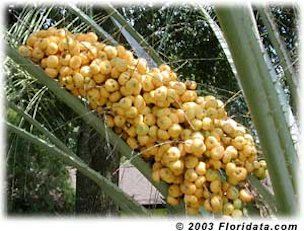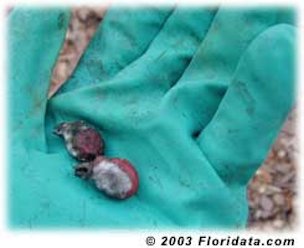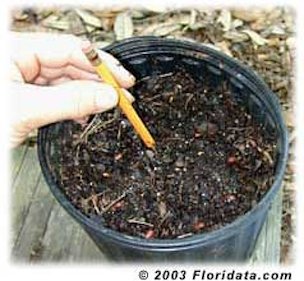From Floridata
by Chuck McLendon
How to Germinate Palm Seeds
 |
| A
ripe cluster of pindo palm (Butia
capitata)
fruit reclines against a leaf stem - for easiest germination collect
the fruit as it drops to the ground. The pindo's flesh, although
fibrous, has a delicious fruity flavor. In the Deep South the fruit is
collected in late summer and made into jelly (this palm is also called
the "jelly palm"). |
Over the years I've tried many different
methods to germinate
palm seeds. Some methods that I've tried are very complex, but I've
learned that for most species, the simpler techniques work just fine.
Presented here are the results of my experiences over the years: an
easy method which yields success. Follow these guidelines and you can
maximize your success germinating palm seeds.
Harvest the
seeds...
It's
best to collect seeds when the palm fruit is completely ripe or as soon
as it falls from the tree. The fresher the seed, the better results you
will have. The probability of successfully germinating palm seeds
decreases with time. The time that seeds remain viable varies widely,
from weeks to years, even among trees of the same species.
Clean them...
Palm
seeds are enclosed in a fleshy or fibrous skin, or wall, that generally
should be removed before germination. The removal of the fleshy part of
the fruit maximizes germination chances and minimizes the chance of
fungus growth and other seed contamination. Caution: some palm seeds
contain an irritant that may aggravate your skin. For example, you may
want to wear rubber gloves when cleaning Chamaedorea seeds.
It
is best to plant the palm seed right after cleaning. If this is not
possible, seal the seed in a plastic bag, and store at about
65-75º F (18-24ºC).
 |
| The
fleshy pulp was not removed from these seeds and is now being attacked
by fungus. |
Soak them...
Before
planting, soak the seed in clean water for at least one day. If you
have more time, you can maximize the chances of germination by soaking
the seed for seven days at room temperature and changing the water
every day. The fact that some seeds float and others may sink is not a
universal sign of how viable the seed is. For example, seeds of some
palm species are dispersed by floating, while other palm seeds may not
float at all.
Sterilize
them...
After
soaking in water, dip the seeds in a 10% solution of household bleach
(one part bleach to ten parts water) to minimize the chance of fungal
growth. Use waterproof gloves or a tool to dip the seeds into the
solution briefly, and then rinse the seeds thoroughly.
 |
| Soak
the seeds in a 10% bleach solution - I use a shot glass - mix 1 shot of
laundry bleach with 10 shots of water. |
Use
any good soil mix that is well drained. Many use a commercial potting
or seed-starting mix that contains sand or other inert material
(Perlite, vermiculate, etc.), that ensures good drainage. Seeds need to
be kept medium wet to damp to maximize germination success.
A golden rule: never
let the seeds dry out as they may die! Also, ensure the
soil has good drainage since overly wet soil can eventually lead to the
seed rotting.
Plant them...
Plant
the seeds just even with the surface of the planting medium. This
allows you to view the seed and still keeps enough soil around it to
keep it uniformly moist. You may plant a number of seeds in a pot.
Allow enough space between them for the young plant to begin
development.
 |
| Use
a pencil to drill a hole in the soil and insert the palm seed so that
it is just peeking above the soil line. |
Germinating
seeds need warmth, not light. Keep the seeds warm in a temperature
range of about 70-100ºF (21-38ºC). Keep the seeds in the
shade or indoors and out of direct sunlight. Sunlight may provide
warmth to seeds, but inevitably leads to the seeds drying out... a
number-one enemy of seed germination.
...and wait...
How
long will palm seeds take to germinate and how many seeds will
germinate? Palms seeds generally are erratic in germination. Different
species, and even seeds from the same species take different times to
germinate. Some seeds will be viable, and some will not be viable.
Although estimates vary widely, about 75% of palm species take less
than 100 days for their seeds to germinate.
...then enjoy!
Following
these guidelines will maximize your chances for successfully
germinating palms. With attention to the little details, you can
germinate some magnificent palms!
|
|



